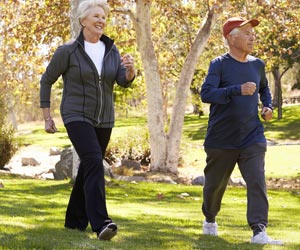A recent study found that people who are older in their active years have a better quality of life.
- Being physically active has been linked to a reduced risk of obesity, cancer, and heart diseases
- A recent study has shown that older adults who were more active had a better quality of life compared to those who were sedentary
- Some ways to incorporate fitness are to take walks, go on a bicycle ride, dance, or play tennis with your buddies
Associations between change in physical activity and sedentary time and health-related quality of life in older english adults: the EPIC-Norfolk cohort study
Go to source).
The same was true for increases in sedentary time, such as watching television or reading. According to the researchers, this underscores the importance of encouraging older people to be active.
Why Working Out is So Important for Older Adults
Physical activity, particularly moderate-intensity activity that boosts your heart rate, has been shown to lessen the risk of a variety of diseases, including heart disease, stroke, diabetes, and cancer. Adults should engage in at least 150 minutes of moderate-intensity activity or 75 minutes of vigorous-intensity activity every week, according to the NHS.Older people are also advised to break up long periods of sedentary behavior with mild activity, or at the very least standing, because it has specific health benefits for them.
Using accelerometers, a team led by researchers from the University of Cambridge assessed the activity levels of 1,433 adults aged 60 and up. The participants had been recruited for the EPIC-Norfolk project (European Prospective Investigation into Cancer).
The Relationship Between Being Active and Quality of Life
Along with this, the researchers examined health-related quality of life, a measure of health and well-being that encompasses pain, self-care, and anxiety/mood. Based on their responses to a questionnaire, participants were assigned a score ranging from 0 (lowest quality of life) to 1 (best). Lower quality of life scores are associated with an increased risk of hospitalization, poor post-hospitalization outcomes, and premature mortality.Participants were followed up on an average of a little under six years later to see if their behavior and quality of life had changed. The study's findings were published in Health and Quality of Life Outcomes.
Six years after their initial examination, both men and women were doing about 24 minutes less moderate-to-vigorous physical activity per day on average. Simultaneously, overall inactive time increased by an average of 33 minutes per day for males and 38 minutes per day for women.
More Physical Activity = Better Quality of Life
Those individuals who did more moderate-to-vigorous physical activity and spent less time sedentary at their first assessment had a higher quality of life later on. An hour a day spent more actively was associated with a 0.02 higher quality of life score (2✔ ✔Trusted SourcePhysical activity guidelines for adults aged 19 to 64
Go to source).
Quality of life ratings fell by 0.03 for every minute less of moderate-to-vigorous physical activity recorded six years after the initial assessment. This suggests that if a person spent 15 minutes a day less engaged in such activity, their score would have dropped by 0.45.
Sedentary behavior increases were also associated with lower quality of life, with a 0.012 drop in score for every one minute per day increase in overall sedentary time six years after the first measurement. This suggests that an individual who sat for an additional 15 minutes every day would have had their score decline by 0.18.
To put the findings into clinical context, a 0.1-point increase in quality of life scores has previously been linked to a 6.9% reduction in premature death and a 4.2% reduction in hospitalization risk.
Dr. Dharani Yerrakalva from the Department of Public Health and Primary Care at the University of Cambridge said: “Keeping yourself active and limiting – and where you can, breaking up – the amount of time you spend sitting down is really important whatever stage of life you’re at. This seems to be particularly important in later life when it can lead to potentially significant improvements to your quality of life and your physical and mental wellbeing.”
Because the researchers examined physical activity and sedentary behavior at separate moments in time, they believe they can be pretty confident that they have demonstrated a causal link - that is, that people's quality of life improves as they become more physically active, for example.
Dr. Yerrakalva added: “There are several ways in which improvements in our physical behaviors might help maintain a better quality of life. For example, more physical activity reduces pain in common conditions such as osteoarthritis, and we know that being more physically active improves muscle strength which allows older adults to continue to care for themselves. Similarly, depression and anxiety are linked to the quality of life, and can be improved by being more active and less sedentary.”
Here are some ways older adults can be physically-active:
Take a walk
: A 20-minute brisk walk daily can be a great way to stay active.Gardening
: Gardening can be a relaxing and fun way to incorporate movement.A Bicycle Ride
: A bike ride around the city can be a great way to see the wonders of your city, all while keeping you fit.Dancing
: Put on your favorite music and dance your heart away.Tennis
: Grab your buddies and play some tennis and who knows you might be your group’s Roger Federer.References:
- Associations between change in physical activity and sedentary time and health-related quality of life in older english adults: the EPIC-Norfolk cohort study - (https://pubmed.ncbi.nlm.nih.gov/37349799/)
- Physical activity guidelines for adults aged 19 to 64 - (https://www.nhs.uk/live-well/exercise/exercise-guidelines/physical-activity-guidelines-for-adults-aged-19-to-64/)
Source-Medindia














